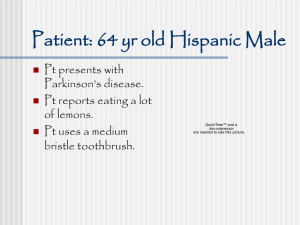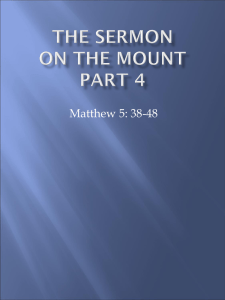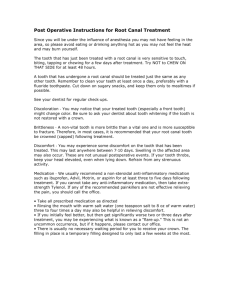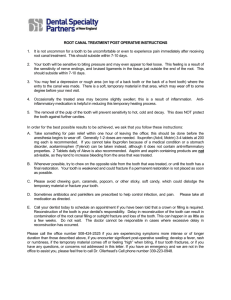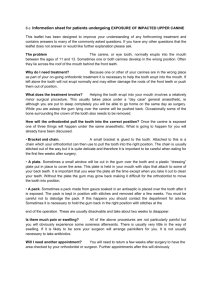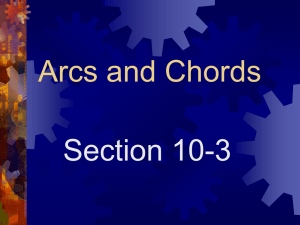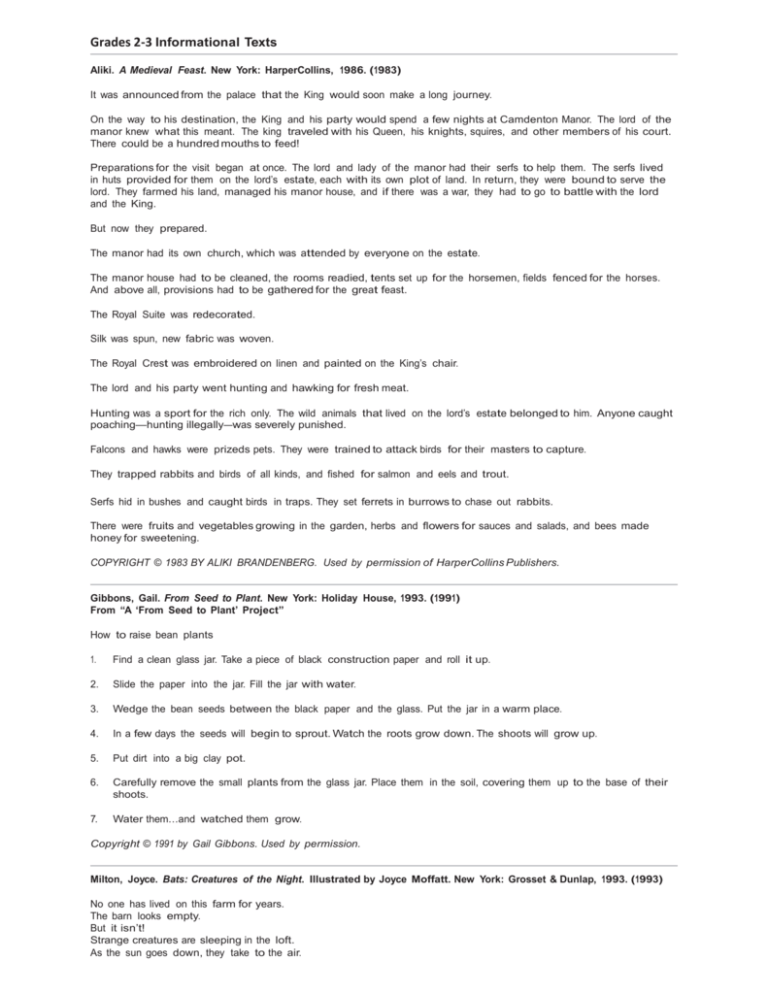
Grades 2-3 Informational Texts
Aliki. A Medieval Feast. New York: HarperCollins, 1986. (1983)
It was announced from the palace that the King would soon make a long journey.
On the way to his destination, the King and his party would spend a few nights at Camdenton Manor. The lord of the
manor knew what this meant. The king traveled with his Queen, his knights, squires, and other members of his court.
There could be a hundred mouths to feed!
Preparations for the visit began at once. The lord and lady of the manor had their serfs to help them. The serfs lived
in huts provided for them on the lord’s estate, each with its own plot of land. In return, they were bound to serve the
lord. They farmed his land, managed his manor house, and if there was a war, they had to go to battle with the lord
and the King.
But now they prepared.
The manor had its own church, which was attended by everyone on the estate.
The manor house had to be cleaned, the rooms readied, tents set up for the horsemen, fields fenced for the horses.
And above all, provisions had to be gathered for the great feast.
The Royal Suite was redecorated.
Silk was spun, new fabric was woven.
The Royal Crest was embroidered on linen and painted on the King’s chair.
The lord and his party went hunting and hawking for fresh meat.
Hunting was a sport for the rich only. The wild animals that lived on the lord’s estate belonged to him. Anyone caught
poaching—hunting illegally—was severely punished.
Falcons and hawks were prizeds pets. They were trained to attack birds for their masters to capture.
They trapped rabbits and birds of all kinds, and fished for salmon and eels and trout.
Serfs hid in bushes and caught birds in traps. They set ferrets in burrows to chase out rabbits.
There were fruits and vegetables growing in the garden, herbs and flowers for sauces and salads, and bees made
honey for sweetening.
COPYRIGHT © 1983 BY ALIKI BRANDENBERG. Used by permission of HarperCollins Publishers.
Gibbons, Gail. From Seed to Plant. New York: Holiday House, 1993. (1991)
From “A ‘From Seed to Plant’ Project”
How to raise bean plants
1.
Find a clean glass jar. Take a piece of black construction paper and roll it up.
2.
Slide the paper into the jar. Fill the jar with water.
3.
Wedge the bean seeds between the black paper and the glass. Put the jar in a warm place.
4.
In a few days the seeds will begin to sprout. Watch the roots grow down. The shoots will grow up.
5.
Put dirt into a big clay pot.
6.
Carefully remove the small plants from the glass jar. Place them in the soil, covering them up to the base of their
shoots.
7.
Water them…and watched them grow.
Copyright © 1991 by Gail Gibbons. Used by permission.
Milton, Joyce. Bats: Creatures of the Night. Illustrated by Joyce Moffatt. New York: Grosset & Dunlap, 1993. (1993)
No one has lived on this farm for years.
The barn looks empty.
But it isn’t!
Strange creatures are sleeping in the loft.
As the sun goes down, they take to the air.
From BATS: CREATURES OF THE NIGHT by Joyce Milton. Text © 1993 by Joyce Milton. Illustrations © 1993 by Judith
Moffatt. Used by permission of Grosset & Dunlap, A Division of Penguin Young Readers Group, A Member of Penguin
Group (USA) Inc. All rights reserved.
Beeler, Selby. Throw Your Tooth on the Roof: Tooth Traditions Around the World. Illustrated by G. Brian Karas. New
York: Houghton Mifflin, 2001. (1998)
Has this ever happened to you?
You find a loose tooth in your mouth.
Yikes! You can wiggle it with your finger.
You can push it back and forth with your tongue.
Then one day it falls out.
There you are with your old baby tooth in your hand and a big hole in your mouth.
It happens to everyone, everywhere, all over the world.
“Look! Look! My tooth fell out! My tooth fell out!”
But what happens next?
What in the world do you do with your tooth?
North America
United States
I put my tooth under my pillow. While I’m sound asleep, the Tooth Fairy will come into my room, take my tooth, and
leave some money in its place.
Mexico
When I go to sleep, I leave my tooth in a box on the bedside table. I hope El Ratón, the magic mouse, will take my
tooth and bring me some money. He leaves more money for a front tooth.
Yupik
My mother wraps my tooth in a food, like meat or bread. Then I feed it to a female dog and say, “Replace this tooth
with a better one.”
Yellowknife Déné
My mother or grandmother takes my tooth and puts it in a tree and then my family dances around it. This makes certain that my new tooth will grow in as straight as a tree.
Navajo
My mother saves my tooth until my mouth stops hurting. Then we take my tooth to the southeast, away from our
house. We bury the tooth on the east side of a healthy young sagebrush, rabbit bush, or pinyon tree because we believe that east is the direction associated with childhood.
Excerpted from THROW YOUR TOOTH ON THE ROOF: Tooth Traditions From Around the World. Text Copyright ©
1998 by Selby B. Beeler. Used by Permission of Houghton Mifflin Harcourt Publishing Company. All rights reserved.
Leonard, Heather. Art Around the World. New York: Rigby, 1998. (1998)
Ruffin, Frances E. Martin Luther King and the March on Washington. Illustrated by Stephen Marchesi. New York:
Grosset & Dunlap, 2000. (2000)
August 28, 1963
It is a hot summer day in Washington, D.C.
More than 250,000 people are pouring into the city.
They have come by plane, by train, by car, and by bus.
From MARTIN LUTHER KING, JR. AND THE MARCH ON WASHINGTON: ALL ABOARD READING by Frances E. Ruffin,
illustrated by Stephen Marchesi. Text © 2001 by Frances E. Ruffin. Illustrations © 2001 by Stephen Marchesi. Used by
permission of Grosset & Dunlap, A Division of Penguin Young Readers Group, A Member of Penguin Group (USA) Inc.
All rights reserved.
St. George, Judith. So You Want to Be President? Illustrated by David Small. New York: Philomel, 2000. (2000)
Every single President has taken this oath: “I do solemnly swear (or affirm) that I will faithfully execute the office of
President of the United States, and will to the best of my ability, preserve, protect, and defend the Constitution of the
United States.”
Only thirty-five words! But it’s a big order if you’re President of this country. Abraham Lincoln was tops at filling that
order. “I know very well that many others might in this matter or as in others, do better than I can,” he said. “But…I am
here. I must do the best I can, and bear the responsibility of taking the course which I feel I ought to take.”
That’s the bottom line. Tall, short, fat, thin, talkative, quiet, vain, humble, lawyer, teacher, or soldier—this is what most
of our Presidents have tried to do, each in his own way. Some succeeded. Some failed. If you want to be President—
a good President—pattern your self after the best. Our best have asked more of themselves than they thought they
could give. They have had the courage, spirit, and will to do what they knew was right. Most of all, their first priority
has always been the people and the country they served.
From SO YOU WANT TO BE PRESIDENT? By Judith St. George, illustrated by David Small. Text © 2000 by Judith
St. George. Illustrations © 2000 by David Small. Used by permission of Philomel Books, A Division of Penguin Young
Readers Group, A Member of Penguin Group (USA) Inc, all rights reserved.
Einspruch, Andrew. Crittercam. National Geographic Windows on Literacy Series. Washington, D.C.: National
Geographic, 2004. (2004)
Kudlinski, Kathleen V. Boy, Were We Wrong About Dinosaurs. Illustrated by S. D. Schindler. New York: Dutton, 2005.
(2005)
Long, long ago, before people knew anything about dinosaurs, giant bones were found in China. Wise men who saw
the bones tried to guess what sort of enormous animal they could have come from.
After they studied the fossil bones, the ancient Chinese decided that they came from dragons. They thought these
dragons must have been magic dragons to be so large. And they believed that dragons could still be alive.
Boy, were they wrong!
No one knows exactly what dinosaurs looked like. All that is left of them are fossil bones and a few other clues. Now
that we think that many of our own past guesses about dinosaurs were just as wrong as those of ancient China.
Some of our mistakes were little ones. When the first fossil bones of Iguanodon were found, one was shaped like a
rhino’s horn. Scientists guessed that the strange horn fit like a spike on Iguanodon’s nose
Boy, were we wrong about Iguanodon!
When a full set of fossil bones was found later, there were two pointed bones, they were part of Iguanodon’s hands,
not its nose!
Other new clues show us that we may have been wrong about every kind of dinosaur.
Some of our first drawings of dinosaurs showed them with their elbows and knees pointing out to the side, like a
lizard’s. With legs like that, big dinosaurs could only waddle clumsily on all fours or float underwater.
Now we know that their legs were straight under them, like a horse’s. Dinosaurs were not clumsy. The sizes and
shapes of their leg bones see to show that some were as fast and graceful as deer.
From BOY, WERE WE WRONG ABOUT DINOSAURS by Kathleen Kudlinski, illustrated by S.D. Schindler. Text copyright © 2005 by Kathleen V. Kudlinski. Illustrations © 2005 by S.D. Schindler. Used by permission of Dutton Children’s
Books, A Division of Penguin Young Readers Group, A Member of Penguin Group (USA) Inc. All rights reserved.
Davies, Nicola. Bat Loves the Night. Illustrated by Sarah Fox-Davies. Cambridge, Mass.: Candlewick, 2001. (2001)
Floca, Brian. Moonshot: The Flight of Apollo 11. New York: Atheneum, 2009. (2009)
High above there is the Moon, cold and quiet, no air, no life, but glowing in the sky.
Here below there are three men who close themselves in special clothes, who—click—lock hands in heavy gloves,
who—click—lock heads in large round helmets.
It is summer here in Florida, hot, and near the sea. But now these men are dressed for colder, stranger places. They
walk with stiff and awkward steps in suits not made for Earth.
They have studied and practiced and trained, and said good-bye to family and friends. If all goes well, they will be
gone for one week, gone where no one has been.
Their two small spaceships are Columbia and Eagle. They sit atop the rocket that will raise them into space, a monster
of a machine: It stands thirty stories, it weighs six million pounds, a tower full of fuel and fire and valves and pipes and
engines, too big to believe, but built to fly—the mighty, massive Saturn V.
The astronauts squeeze in to Columbia’s sideways seats, lying on their backs, facing toward the sky—Neil Armstrong
on the left, Michael Collins in the right, Buzz Aldrin in the middle.
Click and they fasten straps.
Click and the hatch is sealed.
There they wait, while the Saturn hums beneath them.
Near the rocket, in Launch Control, and far away in Houston, in Mission Control, there are numbers, screens, and
charts, ways of watching and checking every piece of the rocket and ships, the fuel, the valves, the pipes, the engines,
the beats of the astronauts’ hearts.
As the countdown closes, each man watching is asked the question: GO/NO GO?
And each man answers back: “GO.” “GO.” “GO.”
Apollo 11 is GO for launch.
Reprinted with the permission of Atheneum Books for Young Readers, an imprint of Simon & Schuster Children’s Publishing Division from MOONSHOT: The Flight of Apollo 11 by Brian Floca. Copyright © 2009 by Brian Floca.
Thomson, Sarah L. Where
Do Polar Bears Live? Illustrated by Jason Chin. New York:
HarperCollins, 2010. (2010) This island is covered with snow. No trees grow. Nothing has green
leaves. The land is white as far as you can see. Then something small and round and black pokes
up out of the snow.
A black nose sniffs the air. Then a smooth white head appears. A mother polar bear heaves
herself out of her den. A cub scrambles after her.
When the cub was born four months ago, he was no bigger than a guinea pig. Blind and helpless,
he snuggled in his mother’s fur. He drank her milk and grew, safe from the long Arctic winter.
Outside the den, on some days, it was fifty degrees below zero. From October to February, the sun never rose.
Now it is spring—even though snow still covers the land. The cub is about the size of a cocker
spaniel. He’s ready to leave the den. For the first time, he sees bright sunlight and feels the wind
ruffle his fur
The cub tumbles and slides down icy hills. His play makes him strong and teaches him to walk and run in snow.
Like his mother, he cub is built to survive in the Arctic. Hi white fur will grow to be six inches
thick—longer than your hand. The skin beneath the cub’s fur is black. It soaks up the heat of the
sun. Under the skin is a layer of fat. Like a snug blanket, this blubber keeps in the heat of the bear’s
body.
Polar bears get too hot more easily than they get too cold. They stretch out on the ice to cool off.
Used by permission of HarperCollins Publishers.


